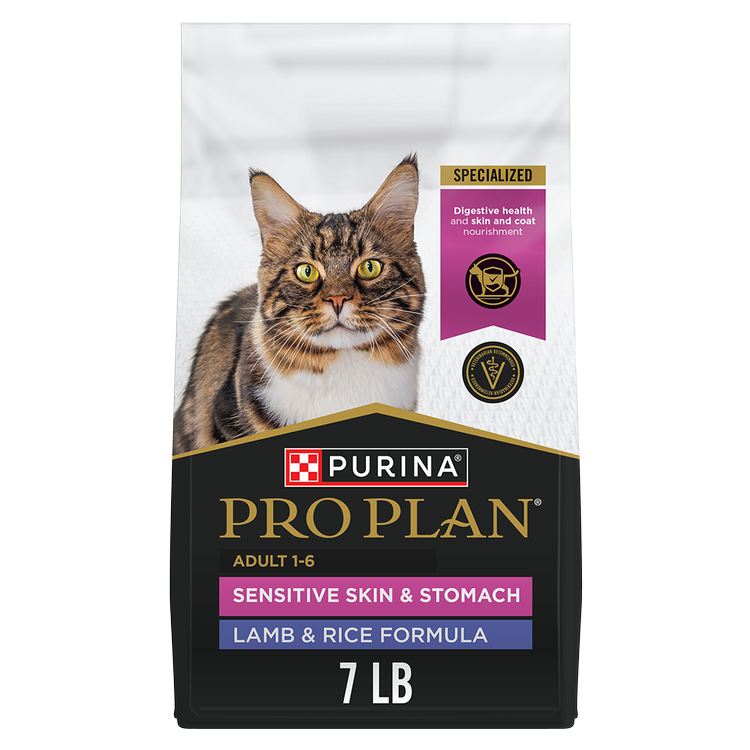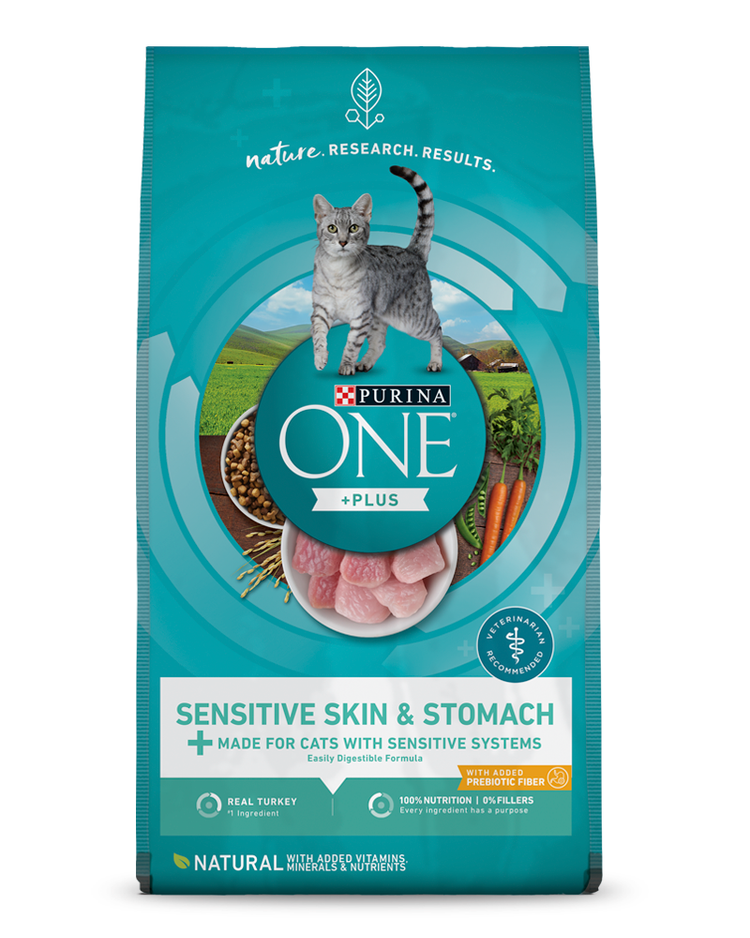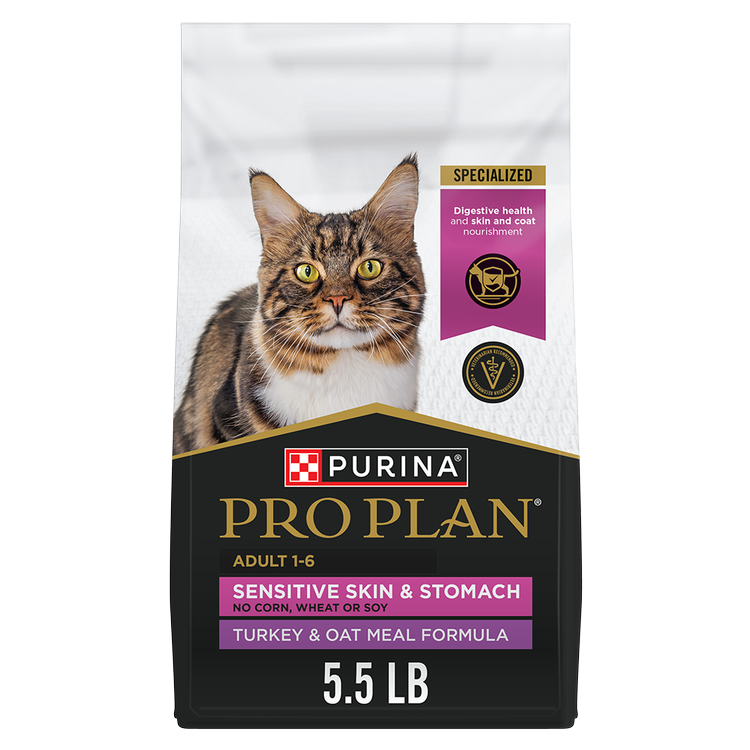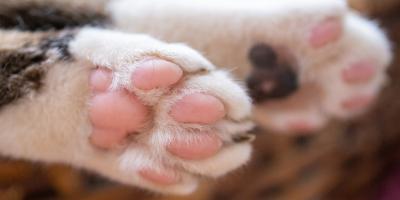Cat Skin Allergies & Allergic Dermatitis: Symptoms & Treatments


Can cats get allergies? Everyone knows some people are allergic to cats; can cats be allergic to people? Not really, but just like people, cats can have allergic reactions to environmental elements and ingredients in their food. Often those allergic reactions show up on their skin.
When allergens are inhaled, absorbed through the skin, or consumed and enter the gastrointestinal tract, they stimulate antibody production. When your cat comes in contact with the allergens again, an allergic response is triggered. You may notice your cat scratches or grooms excessively. You may also notice your cat’s skin is flaky, scaly, and red with hair loss. These are all signs of allergic dermatitis in cats.
What is Allergic Dermatitis in Cats?
Allergic dermatitis is an inflammation of the skin that shows up as itchiness and discomfort. It results in rashes, scabs, and other cat skin allergy symptoms. It can be caused by fleas, food ingredients, or environmental allergens. These allergens trigger an overreaction of your cat’s immune system, manifesting in cat allergy skin rashes.
Causes of Skin Allergies in Cats
There are several causes of skin allergies in cats. And because there are so many possible sources, identifying the true allergen may take time. Possible allergens include:
- Environmental allergens: dust, mold, and pollen
- Proteins in their food
- Parasites including fleas, lice, and mites
Cat Skin Allergy Symptoms
Your cat’s skin should be smooth, supple, and soft without any flaking, redness, scales, or any signs of irritation. Symptoms of allergic dermatitis include:
- Red patches, spots, or pimples
- Scabs, crusts, or thickened skin
- Hair loss
- Flaky or scaly patches
- Bad skin odor
- Excessive itching, scratching, licking, or rubbing to relieve itching
These skin issues can have many causes, so it’s crucial to seek veterinary care at the first sign of skin irritation.
Diagnosing a Cat Skin Allergy
Your vet will want to rule out parasites and fungal infections before identifying allergies as the source of your cat’s irritated skin. A visual examination can determine if it’s fleas. Your vet may take a sample of your cat’s flaking skin, which is called a skin scrape, and examine it under a microscope to see if there are mites or lice present.
Ringworm, a fungal infection, can usually be identified by a physical exam. Ringworm is highly contagious, so if you have more than one cat, and one has ringworm, be sure to isolate that kitty from the rest and take care when petting and grooming that kitty. In addition to physical examination, your vet may take skin scrapes or do other tests to rule out additional fungal infections. If these tests are positive, your vet will recommend a course of treatment for your cat.
If parasites and fungal infections are eliminated as possible causes for skin irritation, the next step is to identify the allergen. Your vet will likely put your cat on a special food to test for a food allergy. If that does not resolve the itching, that means the probable allergen is something in the environment. Your vet may prescribe certain medications or discuss immunotherapy.
Immunotherapy involves allergy skin tests to discover the allergens. Once known, a specific therapy injectable will be formulated to desensitize your cat to environmental allergens. Immunotherapy with allergy shots requires a commitment to long-term management and a cooperative cat.
If skin tests are not an option, you can try removing the suspected allergen from your cat’s environment. Then reintroduce the allergen and look for any changes in your cat’s skin. However, identifying the allergen is not often possible for outdoor or indoor/outdoor cats and can be very difficult for solely indoor cats. If you can identify an allergen, you need to keep it away from your cat.
Cat Skin Allergy Treatment
Your cat’s skin allergy treatment may depend on the source of the allergy. If it’s determined that your cat is allergic to dust, mold, or pollen, limiting exposure to those allergens is important. Keep your cat out of your basement, where he or she is more likely to be exposed to mold and mildew. If your cat likes to go outside, keep him or her inside, especially during the high pollen seasons. Switching to a fragrance-free, dust-free, or clay-free litter can also help, especially if you see any irritation on your cat’s paws or signs of bronchitis and asthma.
As mentioned previously, if an allergy to one or more food ingredients is suspected, you and your vet will identify the allergen with an elimination diet to know what foods to avoid for your cat with skin allergies. For cats, the food allergen is most likely a protein such as chicken, beef, or fish. Allergies to other ingredients, including grains, are rare in cats.
Your vet will probably recommend putting your cat on a hydrolyzed diet for up to 12 weeks. During that time, your cat cannot have any other food – treats, table scraps, or another cat’s food and even flavored medicines.
With hydrolyzed food, the proteins have been broken down into a very small size, so they do not initiate an immune response. After several weeks, the original diet can be reintroduced to see if your cat has an allergic reaction.
If the itchiness goes away with the hydrolyzed diet, and then returns when the previous diet is reintroduced, the allergic protein can be identified and then avoided. At that point, you can introduce novel proteins, such as rabbit, duck, or lamb, and check your cat’s reaction. Read the ingredient label to make sure it does not contain the allergen ingredient. Or you may want to stay with the hydrolyzed diet as sometimes cats can develop allergies to novel proteins over time.
Your cat’s allergic symptoms can be treated with medications as directed by your vet. Don’t try to medicate your cat without consulting your vet. Antihistamines and omega-3 fatty acids may be effective. Corticosteroids may be an option but can have negative long-term effects including diabetes and heart disease. Your vet may prescribe a special medication developed specifically for environmental allergies in cats, and topical treatments to treat any potential secondary infections.
Can the Right Cat Food Help My Cat?
If your cat is allergic to environmental factors, rather than food ingredients, a high-quality protein cat food for skin allergies may be an option. Foods rich in omega-3 fatty acids can help support your cat’s immune system, and foods with omega-6 fatty acids help support a healthy skin and coat.
Identifying the allergen while your cat suffers from skin discomfort takes time. Working together, you and your vet can identify the irritant or allergen, manage a successful treatment plan, and ultimately help your cat’s skin heal.
Want more cat health tips? Get advice from our experts with our other cat health articles.
Related articles

Earn myPurina Rewards with Every Purchase
Use your points for treats, toys, and gift cards with myPurina app.






